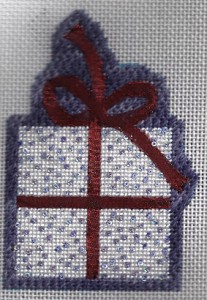
Updated April 19, 2019.
I have had a little needlepoint problem for much of my stitching life. I’ll confess it, I hate to bead. A recent project, as well as many ones in the past have reminded me of this fact. Because you use beading needles to attach other things such as sequins, buttons with small holes, and embellishments, this limits things I can do on my needlepoint.
With my general dislike of beading needles because they are long and sharp, The little present above was a good project to test sequins from The Collection.
Working on this was an exercise in frustration. Although the holes in the 2mm sequins from The Collection were large and easy to see, my needles were mismarked. Instead of having the large eyes of tapestry needles, they had the tiny eyes of hand-sewing needles.
Let me tell you, this makes a HUGE difference. I can’t see the eye. Worse than that even a thin wire threader would not work with my thread. I was about to give up. This was the problem I had recently with the even smaller size 12 beading needles I had to use for small beads. Ultimately with those I gave up.
When I encountered the problem with beading needles on this project I went to my LNS, Needle in a Haystack, and threw myself on their mercy.
They discovered that the needle was wrong and might never have worked except with sewing thread (something I don’t own). But they came up with a some solutions and tips.
- A #28 tapestry needle may work for attaching embellishments. While about the thickness of a beading needle it has a large eye and blunt tip.
- Always test fit your embellishment by making sure the needle can go all the way through. Tapestry needles bulge out at the eye, so smaller holes get stuck. With seed beads the holes are different sizes but most should be able to pass through. If the embellishment’s holes are too small, you’ll have to go to a beading needle.
- Use a thin wire needle threader. Unlike the threaders for cross stitch and needlepoint, the holes in these threaders compress. If you can test it both by itself and with your chosen thread.
- Many beads have sharp edges, strengthen your thread with beeswax or thread conditioner.
- Work in good light with your embellishments in a shallow dish so you can pick them up easily.
I have a few other comments on this that I’ve learned from experience. I always try the #28 needle first with test fitting. It works well for everything but smaller seed beads and ones with small holes. Then I use John James size 10 tapestry-point beading needles. These have points that are less sharp but still don’t bulge at the eye.
For threading the Puffin micro hook threaders also work. I have also had good success with lit thin-wire needle threaders.
I use the Accoutrement beading case to hold my beads, needle, and threader because the beads don’t roll around on it.
About Janet M Perry
Janet Perry is the Internet's leading authority on needlepoint. She designs, teaches and writes, getting raves from her fans for her innovative techniques, extensive knowledge and generous teaching style. A leading writer of stitch guides, she blogs here and lives on an island in the northeast corner of the SF Bay with her family

Oh my I am SO with you! The only thing I hate more than beading is French Knots in cross-stitch.
Beading can be a fiddle so thanks for your tips and info.
Can you give me a clue as to where I can buy the Accoutrement beading case please?This looks like a useful tool but I can’t find them for sale anywhere.
Suggestions appreciated.
Needlepoint shops that carry their magnets can get them. One of mine came from Needlepoint.com and the other, I think, came from homestead Needle Arts. I have also seen them on eBay.
Keep stitching,
Janet